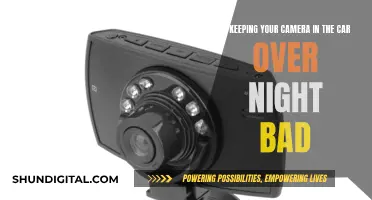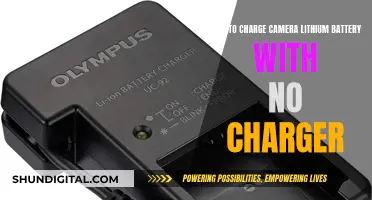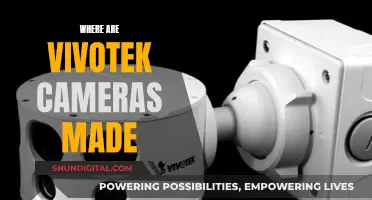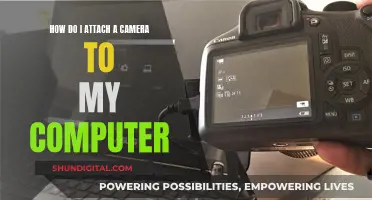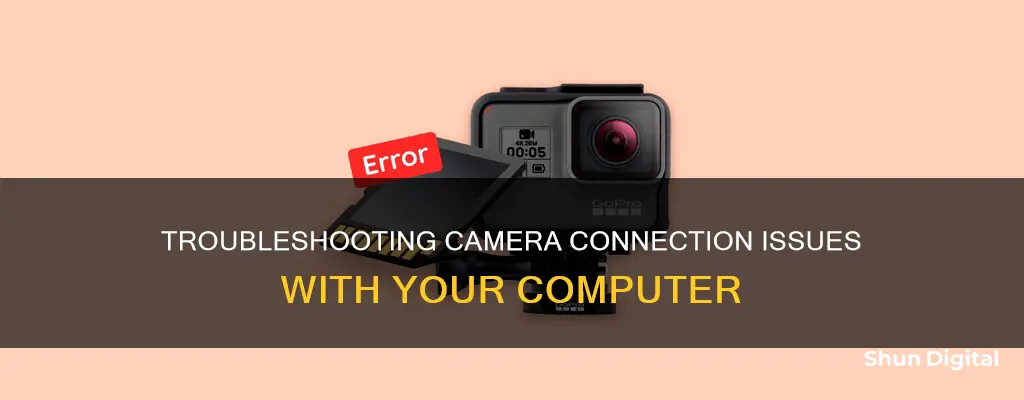
There are many reasons why a computer may not be able to detect a camera. The most common issues are related to USB cables and ports, outdated or missing drivers, and antivirus software blocking access to the camera. If you're using a Windows PC, you can try checking the Device Manager to see if the camera is listed and if there are any issues with the drivers. For macOS, you can check if an additional icon appears on the desktop when the camera is connected. If the computer doesn't recognize the camera, try using a different USB port, restarting the computer, and ensuring that the camera is turned on. If these basic troubleshooting steps don't work, you may need to reinstall camera drivers or software, check your antivirus settings, or refer to the camera manufacturer's website for specific instructions.
| Characteristics | Values |
|---|---|
| Camera not turning on | Check the battery charge level. |
| Camera not recognised by computer | Check the USB cable and port are working. Try connecting the camera to a different USB terminal. |
| Camera driver issues | Reinstall the camera driver. |
| Antivirus software blocking access to the camera | Disable the antivirus software and firewall. |
| Memory card issues | Remove the memory card and clean the contacts with a soft cloth. Try using a card reader. |
What You'll Learn

Check the USB cable and port
If your computer is unable to read your camera, it could be due to an issue with the USB cable or port. Here are some detailed and direct instructions to help you troubleshoot this problem:
Check the USB Cable:
- Ensure you are using the correct USB cable supplied with your camera. This cable may have the manufacturer's name printed on it, such as "Sony Corp." for Sony cameras.
- If you don't have the original cable, use a compatible, commercially available USB cable that supports charging and data transfers. Look for a USB-standard-compliant cable with USB 2.0 or higher.
- Try using a different USB cable to see if that resolves the issue.
Check the USB Port:
- Inspect the USB ports on both your camera and computer for any dust or dirt. Use a soft, dry cloth to gently clean them if necessary.
- Connect your camera to a different USB port on your computer, preferably one that has successfully recognised other devices in the past.
- If your computer has multiple USB ports, try connecting to a port on a different panel (e.g., back panel instead of front panel).
- For desktop computers, note that the front panel USB ports may not be connected, so using a port on the back panel is often recommended.
By following these steps, you can effectively troubleshoot issues related to the USB cable and port when your computer cannot read your camera.
Louisiana's Camera Tickets: Are They Legal?
You may want to see also

Check the camera is turned on
If your computer is not recognising your camera, there are several things you can try.
First, check that your camera is turned on. This may sound obvious, but it is often overlooked. If your camera is not on, simply turn it on and wait for your computer to recognise it.
If your camera is on but your computer still cannot read it, try connecting it to a different USB port. It is also worth checking that the USB port is working by plugging in another device, such as a flash drive. If the USB port is not working, try another one.
If you are using a laptop or portable device, it may have a physical switch or button that turns the camera on or off. These can sometimes be hard to find, so check all possible places, including:
- A button on the keyboard that is activated with the Fn key
- A dedicated camera button on the keyboard
- A sliding switch on the side of the laptop
- A small slider for a shutter, built into the camera
If your camera still isn't working, try turning it off and on again while it is still connected to your computer.
Gaffer's Kit: Should You Include Camera Batteries?
You may want to see also

Check for updates
If your computer is unable to read your camera, it's a good idea to check for updates. This is because, in some cases, your camera might be missing drivers after a recent update.
Windows 11
To check for updates on Windows 11, follow these steps:
- Select the "Start" button.
- Go to "Settings".
- Click on "Windows Update".
- Select "Check for updates".
- If there are no updates available for your camera, try the following:
- Select "Advanced options".
- Choose "Optional updates".
- Look for any driver updates for your camera and install them.
After installing the updates, restart your device.
Windows 10
To check for updates on Windows 10, follow a similar process:
- Select "Start".
- Go to Settings.
- Select "Update & Security".
- Click on Windows Update.
- Select "Check for updates".
- If there are updates available, install them and then restart your PC.
Other Tips:
- If you're using an external camera, try connecting it to a different USB port on your computer.
- Ensure that your camera is turned on and properly connected to your computer.
- Check your camera's battery charge level, especially if it's a new device.
- If you've updated your operating system recently, you might need to give apps permission to use the camera.
By following these steps, you can ensure that your computer's software and drivers are up to date, which may resolve any issues with your camera not being detected or functioning properly.
Waterloo's Camera Tickets: Origins and Insights
You may want to see also

Check camera switch is on
If your computer is unable to read your camera, there are a few troubleshooting steps you can take to resolve the issue.
First, check if your camera is properly connected to your computer. Ensure that the USB cable is securely connected to both the camera and the computer. If you're using an external camera, try using a different USB port on your device. Sometimes, desktop computers do not have their front-panel USB ports connected, so you may need to connect the camera to a USB port on the back panel of your system unit.
Next, check if your camera is turned on. If your camera is not turned on, it won't be recognised by your computer. Some laptops and portable devices have a physical switch or button that turns the camera on or off. This could be a button on the keyboard, a dedicated camera button, a sliding switch on the side, or a small slider built into the camera. Make sure that the switch or button is in the "on" position before using your camera.
If your camera is connected and turned on, but your computer still can't read it, try the following:
- Update your camera driver: If your camera driver is outdated or missing, your computer may not be able to recognise your camera. Check for updates and install any available driver updates for your camera.
- Restart your computer: Sometimes, a simple restart can fix recognition issues.
- Check your antivirus software: Your antivirus program may be blocking the camera. Check your antivirus settings and look for any settings that block access to your camera or permission to use it.
- Check your privacy settings: Ensure that your privacy settings allow camera access for the apps you are trying to use.
Police Arrest in Caught-on-Camera Heist
You may want to see also

Check antivirus software
If your computer is unable to read your camera, it could be due to your antivirus software blocking access to your camera or permission to use it.
- Open your antivirus software settings: Locate the settings menu within your antivirus software. This can typically be found by clicking on the options or gear icon within the software.
- Review the camera-related settings: Within the settings, look for any options or settings related to camera access or permissions. These settings may include blocking or allowing specific applications or functions from accessing the camera.
- Ensure camera access is allowed: Check if there are any blocks or restrictions on camera access. If there are, try disabling or removing them temporarily to see if that resolves the issue.
- Add exceptions or permissions: If your antivirus software allows, add an exception or permission for the specific application or software you are trying to use with the camera. This will allow that application to access the camera without being blocked by the antivirus software.
- Temporarily disable the antivirus software: If the above steps do not work, try disabling the antivirus software temporarily. Ensure that you only do this for a trusted application or software, and remember to re-enable the antivirus protection afterward.
- Contact the antivirus software company: If you are unsure how to adjust the settings or need further assistance, contact the customer support of your antivirus software company. They can provide specific instructions or help troubleshoot the issue.
By following these steps, you can ensure that your antivirus software is not blocking or interfering with your computer's ability to read and access your camera.
Smartphone Camera Focus Lock: How to Engage It
You may want to see also
Frequently asked questions
There could be a number of reasons for this. It could be a faulty USB cable, a faulty USB port, or a problem with the camera's battery. Try connecting your camera to a different USB port and ensure that the cable is securely connected to both the camera and the computer.
Try turning the camera off and on again while it is connected to the computer. Check your device manager to see if your camera is listed. If it is, try updating your drivers.
You can do this by visiting the manufacturer's website and downloading the latest version of the driver.
You may need to uninstall and then reinstall the driver. If this still doesn't work, you may need to contact the manufacturer for further assistance.



